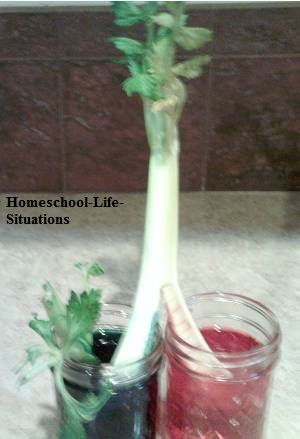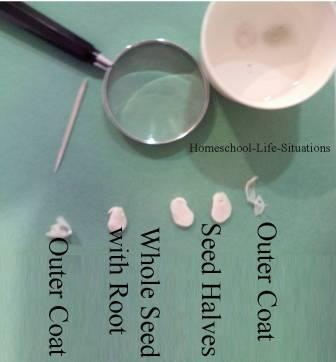Easy Plant Experiments for Homeschooling
I have been doing plant experiments with my children since they were preschoolers. The activities can teach young children patience. But they enjoy watching things grow.
You can do the activities again when your children are older. Older students are expected to learn more terms and do more recording of observations.
Learn how seeds sprout. Observe how plants drink. Grow houseplants from vegetables.
My children have enjoyed learning about plants.
Seeds
Seed Dissection
For this activity you will need;
- 2 large bean seeds such as a lima bean
- A toothpick
- A magnifying glass
- Glass of water
Soak one of the bean seeds overnight in the water. In the morning observe both seeds. The one that has been soaked in the water should be bigger and softer.
Remove the outer coat from the soaked seed. Then divide the bean seed in half. Look at the seed under the magnifying glass. You should see the embryo.
In the embryo you should see small leaves, the stem, and root.
How Seeds Sprout
Here are two plant experiments that will show how seeds sprout.
For the first activity you will need;
- Fresh garden seeds - You can try bean seeds from your kitchen pantry but they may be too dry and not grow.
- Damp paper towel
- Ziploc bag
- A sunny location
Place the seeds on the damp towel. Place the towel in the plastic bag. Seal the bag and place in a sunny location.
Check the seeds every day. In a couple of days the seeds should sprout.
You can also use a clear plastic cup and some garden dirt or dark piece of paper. Place a seed near the edge of the cup so that you can see it. You will need to remember to keep the dirt or paper damp.
What Plants Need
Light
Here are some plant experiments to show what most plants need to grow.
For the first activity you will need;
- Garden dirt
- Seeds
- Two cups
Plant seeds in both cups. Try to plant the seeds at the same depth in both cups. Water the seeds. The dirt should be damp but not soggy. Place one cup in a dark cupboard. Place the other cup on a sunny windowsill. Observe both cups daily. The seed in the sunny windowsill should sprout in several days.
Water
Plants need just the right amount of water. You will need;
- Three cups
- Garden seeds
- Dirt
- Water
In one cup water the dirt so that is moist, but not soggy. In the next cup water the dirt until it is soggy. Don’t water the third cup. Mark the cups. Continue to keep the dirt in the three cups moist, soggy, and dry. Observe the cups daily. The seeds with the moist soil should sprout in several days.
How do Plants Drink?
Here is a fun activity to show how plants drink. You will need;
- Blue or red food coloring
- A celery stick with some leaves
- Glass of water
- Magnifying glass

Color the water with food coloring. Place the celery in the colored
water. After
several hours the leaves should turn the color of the water. For my
activity I spit the celery stock in half. Then place half in blue
water and the other half in red water. It took at least twelve hours
before I could see a change. The blue was easier to see, although it does not show very well in the photo.
Cut about a two inch piece of the stock. Look at it under a magnifying glass. You should see that the strings are the part that is colored.
You can do the same experiment with a white carnation. If I am using a carnation I like to use either green or blue food coloring. Place the carnation in the water. Check your carnation several times a day. It may take several hours or overnight before you see any results.
How Strong Are Plants?
Have you ever noticed plants growing in cracks in a sidewalk? In this activity you can see how it can happen.
For this activity you will need;
- Soil
- Plastic cup
- Three bean seeds
- Plaster of Paris
Place the soil in the cup. Plant the bean seeds in the soil. Mix some plaster of Paris with water. Place the mixture over the soil. The plant should break the plaster of Paris when it sprouts.
Other Activities
You can use the fruit and vegetables that you eat for plant experiments.
One idea is to grow a plant from a sweet potato. You may need to find an organic sweet potato. Many of the regular potatoes will not sprout. Poke toothpicks into the sweet potato. Place one end in bowl of water. After a time roots should grow. Then a green vine should appear.
Carrot tops will sometimes also grow in water.
Try growing an avocado seed. I have not been very successful with this. All the times I have tried I have only succeeded once. What I did was poke toothpicks into the seed. I then placed one end into a glass of water.
You can prorogate some plants with stem cuttings. Cut a stem from an ivy houseplant. The stem should have some leaves. Place the stem in a glass of water. Soon the stem should grow roots. When the roots appear plant the stem into some moist soil. The ivy should grow.
By doing plant experiments we have learned about how seeds grow. The activities can also be fun homeschool science fair projects.
Leave Plant Experiments for Homeschooling Science


New! Comments
Leave me a comment in the box below.